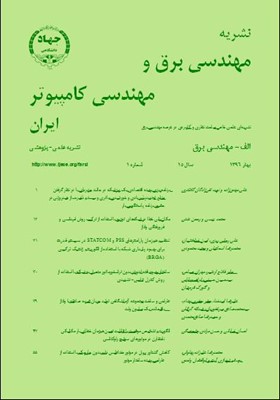تشخیص و تعیین سهم منابع میانهارمونیک در سيستمهای قدرت با استفاده از نرون خطی وفقی و روش جمع آثار و تصوير
محورهای موضوعی : مهندسی برق و کامپیوترپریسا سرافرازی 1 , حميدرضا محمدی 2 *
1 - دانشگاه کاشان
2 - دانشگاه برق و کامپيوتر
کلید واژه: منبع میانهارمونیک روش جمع آثار و تصویر نرون خطی وفقی تعیین سهم منابع میانهارمونیک,
چکیده مقاله :
در این مقاله روش جدیدی برای تشخیص بارهای تولیدکننده میانهارمونیک در سیستم قدرت و همچنین تعیین سهم هر یک از این بارها در تولید میانهارمونیک جريان در نقطه اتصال مشترک ارائه شده است. اساس این روش بر پایه روش جمع آثار و تصویر میباشد که به مدار معادل نورتن بارها و شبکه نیاز دارد. همچنین در روش پیشنهادی، از نرون خطی وفقی دومرحلهای برای تعیین مؤلفههای میانهارمونیک سیگنال استفاده شده است. کارایی روش پیشنهادی به کمک شبیهسازی در محيط نرمافزار MATLAB/SIMULINK نشان داده شده است. نتایج شبیهسازی مؤید قابلیت روش فوق در جایابی منابع میانهارمونیک و تعیین سهم آنها میباشد.
In this paper a new method for identification of interharmonic producing loads in a power system is proposed which is capable of evaluating the contribution of each individual load in the point of common coupling. This method is based on using the superposition and projection method which needs the norton equivalent circuit of loads and supply network. Also in the proposed method, a two-stage adaptive linear neuron is used for determining the interharmonic components of a signal. The effectiveness of the proposed method has been shown through simulation studies in the MATLAB/SIMULINK software. The simulation results show the capability of the proposed method for identification and contribution evaluation of interharmonic sources in a power system.
[1] J. D. Srinivasan, W. S. Ng, and A. C. Liew, "The neural-network-based signature recognition for harmonic source identification," IEEE Trans. on Power Delivery, vol. 21, no. 1, pp. 398-405, Jan. 2006.
[2] E. Gursoy and D. Niebur, "The harmonic load identification using complex independent component analysis," IEEE Trans. on Power Delivery, vol. 24, no. 2, pp. 285-292, Oct. 2009.
[3] H. E. Mazin, W. Xu, and B. Huang, "Determining the harmonic impacts of multiple harmonic producing loads," IEEE Trans. on Power Delivery, vol. 26, no. 2, pp. 1187-1195, Oct. 2011.
[4] S. Nath, P. Sinha, and S. Kumar Goswami, "A wavelet based novel method for the detection of harmonic sources in power systems," International J. of Electrical Power & Energy Systems, vol. 40, no. 1, pp. 54-61, Sept. 2012.
[5] D. Saxena, S. Bhaumik, and S. N. Singh, "Identification of multiple harmonic sources in power system using optimally placed voltage measurement devices," IEEE Trans. on Power Delivery, vol. 61, no. 5, pp. 2483-2492, May 2014.
[6] T. Tayjasanant and W. Xu, "A case study of flicker/interharmonic problems caused by a variable frequency drive," in Proc. Int. Conf. Harmonics Quality of Power, pp. 72-76, Lake Placid, NY, USA, 12-15 Sept. 2004.
[7] T. Kim, E. J. Powers, W. M. Grady, and A. Araposta, "Real and reactive power analysis for interharmonics," in Proc. IEEE ElectricShip Technologies Symp., pp. 244-247, 27-27 Jul. 2005.
[8] M. B. Rifai, T. H. Ortmeyer, and W. J. McQuillan, "Evaluation of current interharmonics from AC drives," IEEE Trans. on Power Delivery, vol. 15, no. 3, pp. 1094-1098, Jul. 2000.
[9] A. M. Dan, "Identification of a flicker source," in Proc. Int. Conf. Harmonics Quality of Power, pp. 1179-1181, Athens, Greece, Oct. 1998.
[10] P. G. V. Axelberg and M. J. Bollen, "An algorithm for determining the direction to a flicker source," IEEE Trans. on Power Delivery, vol. 21, no. 2, pp. 755-760, Apr. 2006.
[11] P. G. V. Axelberg, M. J. Bollen, and I. Y. Gu, "Trace of flicker sources by using the quantity of flicker power," IEEE Trans. on Power Delivery, vol. 23, no. 1, pp. 465-471, Jan. 2008.
[12] A. B. Nassif, J. Yong, H. Mazin, X. Wang, and W. Xu, "An impedance-based approach for identifying interharmonic sources," IEEE Trans. on Power Delivery, vol. 26, no. 1, pp. 333-340, Jan. 2011.
[13] G. W. Chang, C. I. Chen, and Q. W. Liang, "A two-stage ADALINE for harmonics and interharmonics measurement," IEEE Trans. on Ind. Electron., vol. 56, no. 6, pp. 2220-2228, Jun. 2009.
[14] H. Li, Z. Li, W. A. Halang, B. Zhang, and G. Chen, "Analyzing chaotic spectra of DC-DC converters using the Prony method," IEEE Trans. on Circuits Syst., vol. 54, no. 1, pp. 61-65, Jan. 2007.
[15] E. A. Feilat, "Detection of voltage envelope using Prony analysis-Hilberttransform method," IEEE Trans. on Power Delivery, vol. 21, no. 4, pp. 2091-2093, Oct. 2007.
[16] M. M. Tawfic and M. M. Morcos, "ANN-based techniques for estimating fault location on transmission lines using Prony method," IEEE Trans. on Power Delivery, vol. 16, no. 2, pp. 219-224, Apr. 2001.
[17] E. Thunberg and L. Soder, "A norton approach to distribution network modeling for harmonic studies," IEEE Trans. on Power System, vol. 4, no. 1, pp. 174-182, Jan. 1999.

